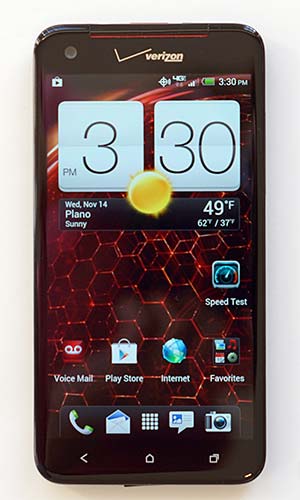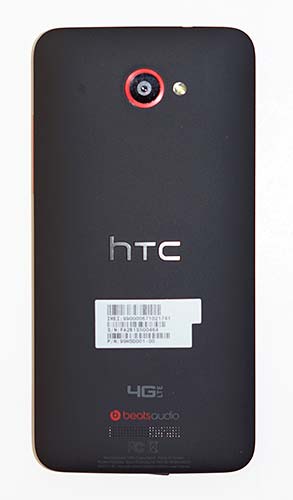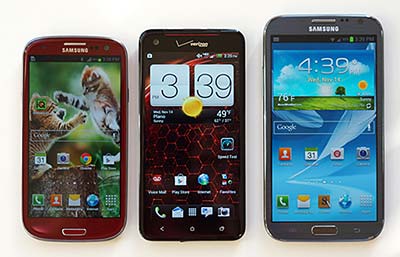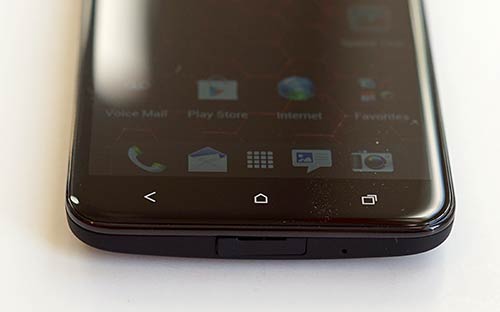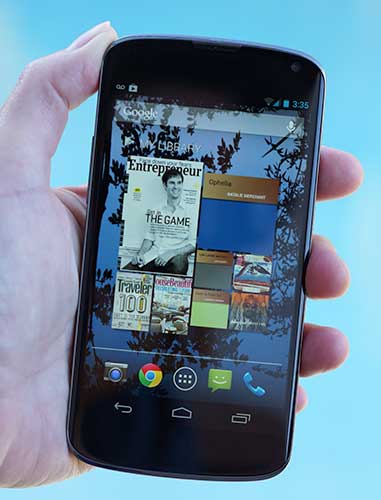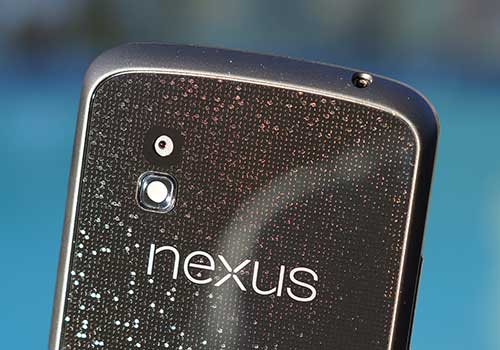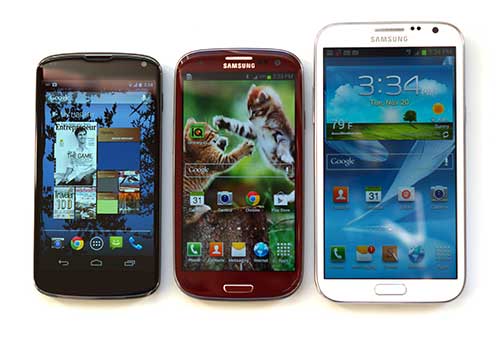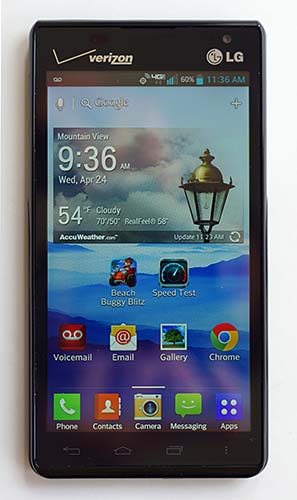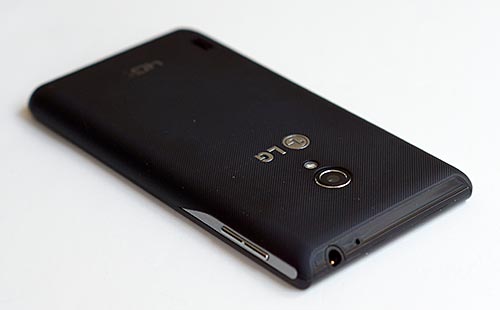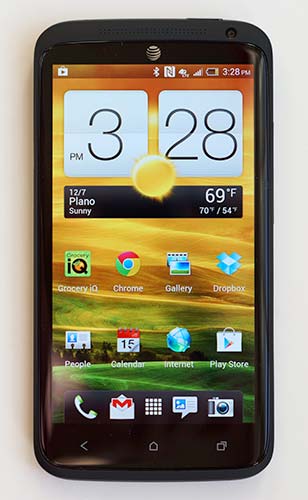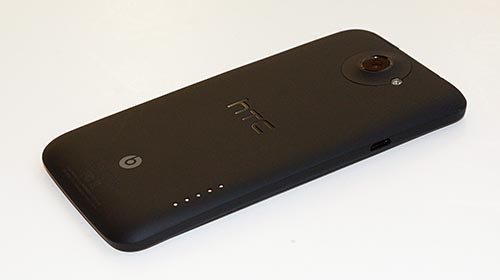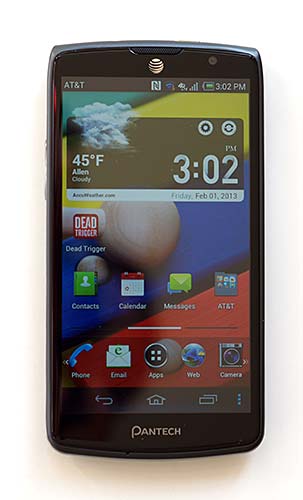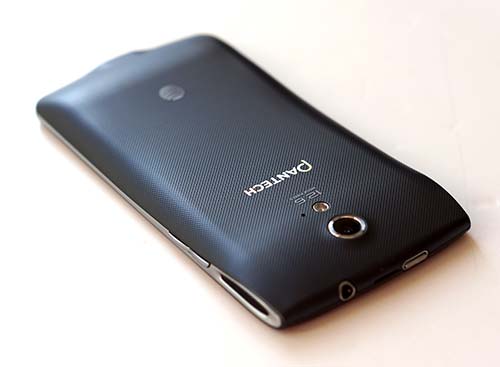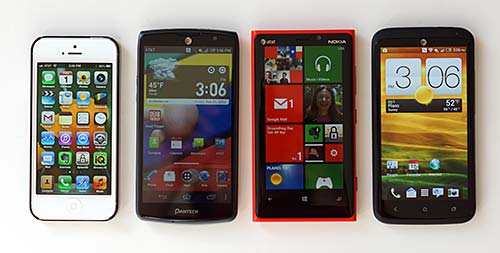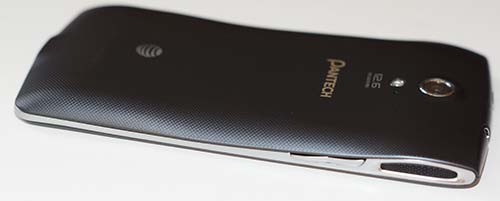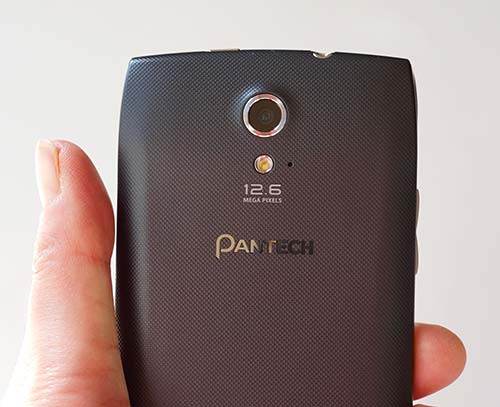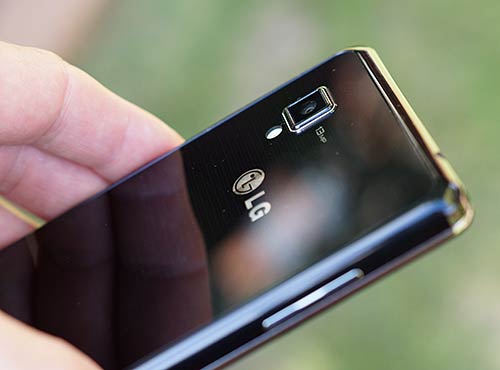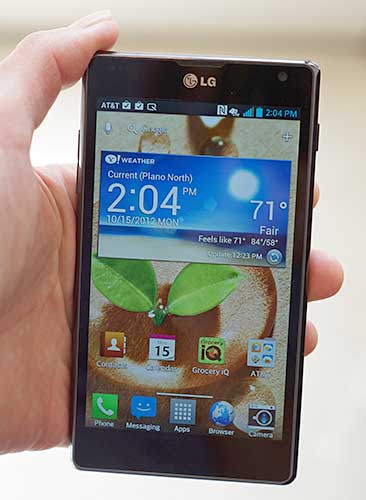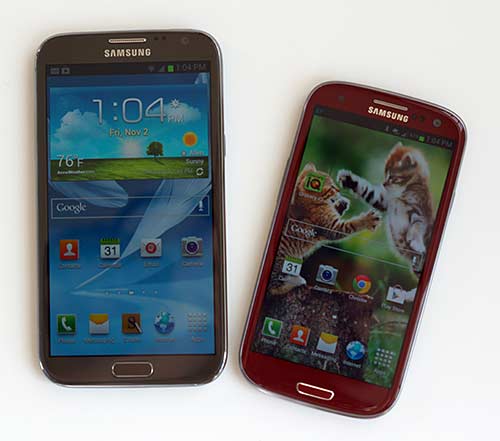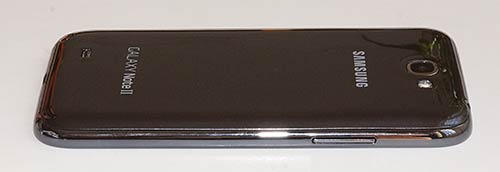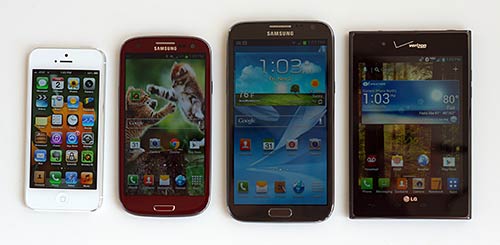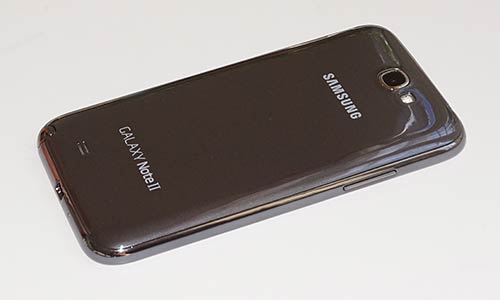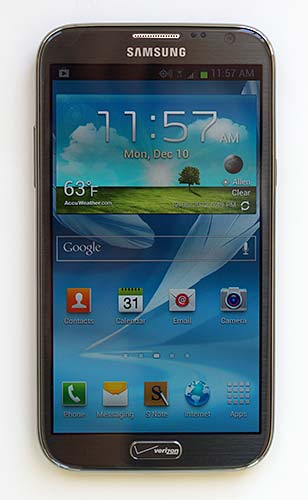The BlackBerry Z10, running BlackBerry 10 is at long last here in the US. AT&T is the first bearer to discharge the Z10, and that is the model we'll audit here, with incidental notice of the opened US show STL100-3 that we additionally have in house. As far as both equipment and programming, the AT&T adaptation (additionally a STL-100-3) is about indistinguishable to its opened US and Canadian cousin, and just a little AT&T logo on the back doles it out. There are only a couple of bearer applications like AT&T Family Maps and an alternate route to the AT&T account administration entrance, making for a clean ordeal.

BlackBerry Z10
This is an unadulterated touch screen telephone with no equipment QWERTY console. Rather a competent programming console deals with your content passage needs. The 4.2", 1280 x 768 IPS showcase is sharp and attractive. The BlackBerry Z10 keeps running on a 1.5GHz double center Qualcomm CPU with 2 gigs of RAM and 16 gigs of inside capacity. Those are sufficiently muscular specs to make the cell phone's pervasive multi-tasking smooth. The Z10 has a back 8MP camera that can shoot 1080p feature and a front 2MP camera that can shoot 720p feature. Remote is very much secured with LTE 4G and HSPA+, double band WiFi, Bluetooth 4.0, GPS and NFC. The telephone has the versatile hotspot highlight and great gathering.
Outline and Ergonomics
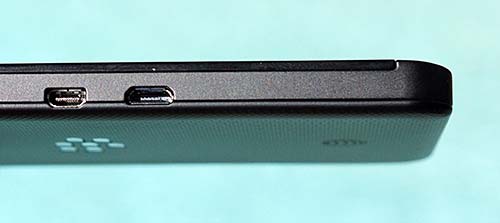
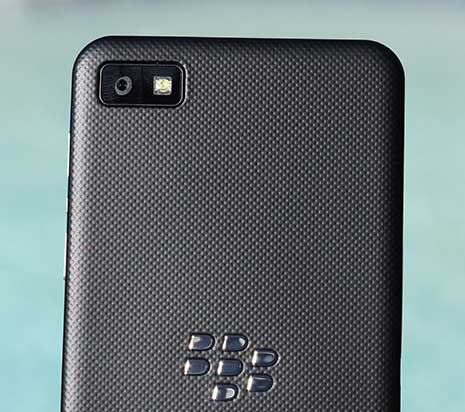
BlackBerry Z10BlackBerry Z10
The Z10 is a satisfying looking cell phone that is generally minimized by today's standards. At 4.2", the Z10 feels a great deal like the iPhone 5s regarding size and screen measurements. I for one lean toward bigger presentations at 4.5" and above for the bigger content and more immersive feature watching knowledge, yet there's something to be said for a telephone that is still sufficiently little to be agreeable to use as a telephone. It fits effortlessly enough in a pocket and the textured, rubbery back isn't elusive. The telephone is generally make of plastic with a stainless steel inward casing, stainless steel catches and the front could trick you in light of the fact that it looks such a great amount like metal. The look is strikingly like the iPhone 5 and HTC One from the front, however Apple and HTC's putting forth look much more tasteful from the back and additionally energizing generally. That said, the BlackBerry Z10 is appealing looking, regardless of the fact that it doesn't wander a long way from the dark piece look (Verizon clients have the alternative to get a white Z10 alongside the typical dark model).
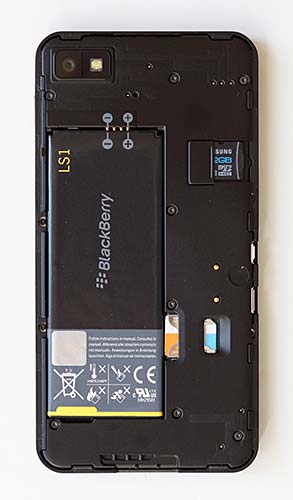
BlackBerry Z10
We won't gripe a lot about that plastic back in light of the fact that it considers a slight telephone with a removable back spread. That implies you can swap out the battery and there's a SDXC microSD card opening under the back spread and the small scale SIM card space. Removable batteries and capacity cards appear to be going the method for the blessed messengers, so we're excited to see it here. Given BlackBerry's administration and business legacy, the capacity to swap in an extra battery out and about is an absolute necessity.
Controls are anything but difficult to utilize, and we like that the middle catch that is sandwiched between the volume catches does twofold obligation to raise voice command. Be that as it may, we discovered voice command choice restricted and the telephone's voice acknowledgment aptitudes unremarkable -it doesn't rival Siri or the great voice acknowledgment framework in Android. Indeed, even Windows Phone improves (Windows Phone 8 has fabulous acknowledgment aptitudes however a constrained arrangement of commands).
The force fasten top is simply right: simple to press when you need it, however not simple to press incidentally. The cell phone has both miniaturized scale USB (for charging and information exchange) and a smaller scale HDMI port on the left side. The front camera is counterbalance to the right side a tad and the back camera is at the upper right corner close to a LED streak. And no, there's no home catch, be it physical or programming based. As you'd anticipate from a BlackBerry, there's a notice LED on the front over the presentation.
BlackBerry OS 10
The cell phone's crisp new OS helps us emphatically to remember the PlayBook, which thus helps to remember us of webOS. The symbols have that mark BlackBerry styling as do menu text styles, however the swipe signals are immaculate PlayBook (with a gesture to webOS motions and card illustration). BlackBerry OS 10 and the PlayBook OS have a ton in like manner, with an establishment in the extremely hearty and secure QNX working framework. The uplifting news is that the telephone is quick and liquid and greatly stable. It doesn't ease off following a day or two and oblige a reboot as Android at times does. We had the web program quit once amidst a page load, however that didn't bring down the OS and it just happened once in 10 days of utilization.
Stream, or signals are the heart of route, and they're enhanced for one-handed utilization. Swipe up to minimize an application and it will then turn into a "Dynamic Pane" that keeps running at 1/4 screen size. A few applications will upgrade in Active Pane mode, and its difficult to figure which ones, and you can have up to 8 applications running in this multi-tasking mode. Begin a ninth application and the OS will begin shutting other running applications (or you can tap the little x at the upper right corner of an Active Pane to close that application yourself).
Your home screen is a three section encounter: a multi-screen palette of symbols much as you see on the iPhone and Android, the Active Pane multi-tasking region where you can swipe here and there to view every open application and the BlackBerry Hub that serves as your one-stop area for instant messages, messages, informal community notices, updates and application overhaul takes note. You'll swipe from side to side to get to these three fundamental regions. At the point when in an application that has menu alternatives, you'll either see three stacked spots on the base right edge of the screen or you can swipe down to see any accessible choices. This isn't predictable from application to application, tragically.
We discovered the console simple to utilize and content forecast was snappy and objective. You can acknowledge a proposed word with a swipe up, which isn't the fastest approach to do things as far as convenience, yet BlackBerry is plainly infatuated with swipe signals. In general, this is one of the best on-screen consoles available.
The cell phone business sector is a mercilessly aggressive spot, and I must say that BlackBerry was shrewd to hold up until their new OS was super-steady, quick and highlight complete. Keep in mind not very far in the past Apple and Android turned out missing essential components like outsider application bolster (iOS), cut and glue (iOS, Android and Windows Phone) and multi-tasking (iOS and Windows Phone). Quick forward a couple of years and it isn't even beneficial to discharge an OS missing those staples. All the fundamentals are here with BlackBerry OS 10, and we commend them, regardless of the possibility that they don't have an "executioner element" that contending working frameworks need.
BlackBerry Hub and Email
I adore BlackBerry Hub, I admit. One spot to take a gander at and communicate with all the things imperative: what a gift from heaven! From email to messages to programming overhaul notification and tweets; its all there. Twitter messages are strung, which is eminent on the off chance that you have a ton of twitter discussions with outsiders as I do. You can answer to interpersonal organization messages, messages and messages straightforwardly from Hub, and truth be told there's no devoted email application. Yes, the telephone has email with backing for MS Exchange, Exchange Activesync, POP, IMAP (counting IMAP unmoving for a push-like ordeal), yet there's no symbol for an email application, not to mention the different email symbols BlackBerry 7 accommodated every email account.
BlackBerry was synonymous with world class email for a considerable length of time, and now its one of the stage's less stellar components. I admit, a brought together email inbox simply doesn't work for me as a business client: I have to hop on my vital work messages in the first place, and stress over my own records just when I have time. I don't generally need them blending, and I'm not excited at needing to tap on the Hub's caret to channel my email record view. Since I'm not a BES 10 client, I can't depend on BlackBerry's clever BlackBerry Balance highlight to particular individual and business messages. That is me, perhaps you'll cherish it. I don't care for the unfied iOS inbox either. Envelope administration has been a touch carriage for me (now and again messages in envelopes don't show up) and mass message administration shouldn't include chasing (tap and hang on a message until a side menu seems, then you can pick the "Select More" capacity its the last choice).
Gmail is handled as IMAP sit still naturally since Google quit offering Exchange Activesync with the expectation of complimentary records on Feb. 1, 2013. In the event that you pay Google $5/month, you can have your EAS back. The first occasion when I set up my Gmail account, it took around 10 minutes for new messages to go to the Z10, while they arrived right away on my Samsung Galaxy Note II, Nokia Lumia 920 and iPhone 5s running the Gmail application. IMAP unmoving ought to be faster than that... so I erased my Gmail accounts and made them once more. Second time it worked fine and messages touched base inside of 15 seconds of my different telephones. Peculiar. On a positive note, HTML messages look dazzling and Exchange has exactly the intended effect. You can utilize the telephone with BES 10 (BlackBerry Enterprise Server) however not BIS.
Programming Selection: Just Starting Out
As ever with another cell phone OS, application determination is thin. Shockingly, amusement choice is an in number point in the youngster BlackBerry World that now likewise offers feature buy and rentals in organization with Rovi and a music store. Applications like Netflix are MIA however WhatsApp, Flixster and Adobe Reader are there. The telephone ships with a decent starter arrangement of applications including Docs to Go for your MS Office needs (view, alter and make MS Word and Excel and perspective/alter PowerPoint), a lovely number cruncher composed by The Astonishing Tribe, PIM applications, BBM, Adobe Reader, Twitter, Facebook, LinkedIn, Foursquare, Box and DropBox and a document administrator. There's a YouTube application (really an alternate route to the portable YouTube webpage), climate, a clock with cautions, average voice command and a decent HTML5 web program with Adobe Flash backing and a Reader mode that works more dependably than the iPhone's. BlackBerry Maps offers fundamental 2D maps with no POIs and 3D driving bearings with talked route. BlackBerry Hub brings content messaging, updates, email and BBM together alongside long range interpersonal communication redesigns. BlackBerry says there are as of now 100,000 applications in BlackBerry World, yet this is amount over quality. Numerous name brand mainstream applications from iOS and Android aren't here, yet there are a considerable measure of garbage applications. Too much. We'd love to see BlackBerry increase current standards for applications in light of the fact that these low quality applications don't make a decent impression.
As a comfort, it should be genuinely simple for engineers to port their Android applications over to BlackBerry 10, so we ought to see application choice keep on growwing rapidly. These non-local applications have a tendency to run somewhat slower, however for lightweight applications, its not really an issue. Imaginative nerds can snatch Android apk application records and self-sign them and send them to their BlackBerry Z10 over USB. On the off chance that you understand what I simply said, this may be for you. If not, its most likely excessively techy or dull.
Call Quality and Data
The BlackBerry Z10 is a brilliant voice telephone with close landline clarity and totality for approaching and active voice. Volume is normal for approaching voice and louder than normal for active voice. The speakerphone is extremely viable (we like it preferred for speakerphone over mixed media), and its sufficiently boisterous for huge box stores.
Information speeds on AT&T's LTE system with both the AT&T rendition and the opened model are great. There's still horrible rate test application in BlackBerry World, yet subjectively sites stacked rapidly and application downloads were rapid. Gathering is great and the telephone doesn't endure passing grasp gathering drops when you wrap your hand around it.
Presentation and Multimedia
The BlackBerry Z10 has a sublime 4.2" 1280 x 768 IPS touch screen with 356ppi pixel thickness and its one of the better looking available. It's right up there with the iPhone 5 and HTC One X for survey points, sharpness and hues. It's additionally sufficiently splendid to be effortlessly distinguishable in daylight. Top and base bands secure the glass since this isn't Gorilla Glass. Content is sharp and features look awesome, however shading immersion isn't exactly as high as the iPhone 5 or Nokia Lumia 920. The BlackBerry Z10 underpins a genuinely wide mixed bag of feature configurations including MOV, MPEG4, WMV, Xvid and AVI. Toss your films on a microSD card and the implicit feature player will discover them and play them. The base terminating speaker isn't too boisterous yet it is clear and doesn't mutilate. Sound through earphones and stereo Bluetooth is great.
Battery Life
I miss a couple of things from BlackBerry 7, including booked on-off times and better control over presentation splendor. The encompassing light sensor never rests: there's no real way to handicap it. That implies in the event that you set the telephone to max shine (and you'll presumably wind up doing only that), you won't get max brilliance. Rather you'll get a moderately brighter setting that is still darkened if the telephone is inside under so-so lighting. Planned on-off is gone, yet there is a simple to get to calm mode for sleep time that you'll see on the lock screen (swipe down to initiate it from the lock screen). This raises the cherished BlackBerry bedside clock with snappy access to cautions, which will work in bedside mode.
The BlackBerry Z10 has a removable 1800 mAh Lithium Ion battery. That is not a gigantic limit battery by today's cell phone standards, yet its adequate to power the telephone during a time of moderate utilization. At the point when the telephone initially dispatched in Canada and a couple of different markets a month back, battery grumblings were basic, yet BlackBerry has discharged an OS upgrade with 60 battery changes and the AT&T Z10 is running that upgraded OS. Battery life has been superbly sensible for a cutting edge cell phone, however the BlackBerry Z10 doesn't trounce the opposition -it only keeps up. The telephone charges decently fast: it took 2.4 hours to charge the battery from 10% to 100% and only an hour to charge it from 40% to 100%. In case you're a moderate client, you'll charge the Z10 every day, and in case you're a light client you'll charge it each other day. In case you're an overwhelming client, you'll have to top up by late evening or purchase an extra battery.





